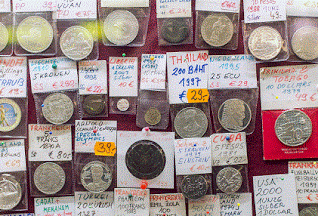 |
| coin collection |
Hammons, here making his fourth visit to the DotD podium, pumped out a lot of words; but the staff numismatist¹ was unimpressed by his knowledge (what little there was of it). Anyone who knows anything at all about collecting anything knows that the keys to value are scarcity and condition and, of course, the law of supply and demand. Bryce, however, figured he needed to introduce his topic with the rather bizarre opening line,
"Whether you’re a prospective buyer looking to find that perfect coin, or a seller looking to finally cash in on your collecting hobby, it’s imperative to know and understand current prices within the market."We call bullshit: you don't need to know and understand (talk about redundant) current prices; you need to have access to a trustworthy vendor who is tapped into market prices. Besides, what "prospective buyer" is wandering the streets looking for "that perfect coin," anyway? Unless you've already gotten pretty deeply into collecting, you are very unlikely to be looking for a specific coin, and if you're that deeply into numismatics, you have a handle on pricing... idjit.
Bryce's best advice (no, really) was to visit a large coin dealer's website for some basics. We couldn't agree more. On the other hand, Hammons also sent people to a site for professional coin grading, of which he warbled,"The PCGS.com site (Professional Coin Grading Service) offers a price guide that is as in-depth as it is enormous..."Sadly, Bryce did not seem to understand that the prices are for coins of a specified grade. For instance, the value of a 1911-D Lincoln cent can range from less than a dollar to almost $2000. How do you tell the difference, especially at the high end. What Hammons didn't mention is that PCGS will happily grade a coin for you... for a fee. If the coin is worth less than $300, it'll cost you $22 ($16 if the coin was minted after 1964), plus shipping. Not exactly what Hammons had in mind, we don't think. Finally, Bryce said that, |
"...the most important aspect of selling [is] to know the value of your collection. Using the previously mentioned sites online, one can begin the process of locating specific pieces and using multiple avenues in which to find what they are worth in today’s economy."Apparently, our Dumbass of the Day thinks people only have a handful of coins in their collection (the staff numismatist has thousands, most worth little more than face value). We repeat what we said before: find a reputable dealer. This is one of the few areas in which libertarian ideals actually work: a dealer who isn't trustworthy won't be around for long.
¹ numismatist: a coin collector
copyright © 2020-2023 scmrak
DD - HOBBIES
No comments:
Post a Comment